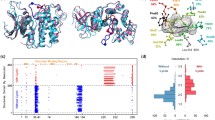Abstract
While it may seem intuitive that using an ensemble of multiple conformations of a receptor in structure-based virtual screening experiments would necessarily yield improved enrichment of actives relative to using just a single receptor, it turns out that at least in the p38 MAP kinase model system studied here, a very large majority of all possible ensembles do not yield improved enrichment of actives. However, there are combinations of receptor structures that do lead to improved enrichment results. We present here a method to select the ensembles that produce the best enrichments that does not rely on knowledge of active compounds or sophisticated analyses of the 3D receptor structures. In the system studied here, the small fraction of ensembles of up to 3 receptors that do yield good enrichments of actives were identified by selecting ensembles that have the best mean GlideScore for the top 1% of the docked ligands in a database screen of actives and drug-like “decoy” ligands. Ensembles of two receptors identified using this mean GlideScore metric generally outperform single receptors, while ensembles of three receptors identified using this metric consistently give optimal enrichment factors in which, for example, 40% of the known actives outrank all the other ligands in the database.




Similar content being viewed by others
References
Leach AR, Shoichet BK (2006) J Med Chem 49:5851
Perola E, Walters WP, Charifson PS (2004) Proteins 56:235
Friesner RA, Banks JL, Murphy RB, Halgren TA, Klicic JJ, Mainz DT, Repasky MP, Knoll EH, Shelley M, Perry JK, Shaw DE, Francis P, Shenkin PS (2004) J Med Chem 47:1739
Halgren TA, Murphy RB, Friesner RA, Beard HS, Frye LL, Pollard WT, Banks JL (2004) J Med Chem 47:1750
Friesner RA, Murphy RB, Repasky MP, Frye LL, Greenwood JR, Halgren TA, Sanschagrin PC, Mainz DT (2006) J Med Chem 49:6177
Zhou Z, Felts AK, Friesner RA, Levy RM (2007) J Chem Inf Model 47:1599
Bernstein FC, Koetzle TF, Williams GJ, Meyer EF Jr, Brice MD, Rodgers JR, Kennard O, Shimanouchi T, Tasumi M (1977) J Mol Biol 112:535
Sutherland JJ, Nandigam RK, Erickson JA, Vieth M (2007) Lessons in molecular recognition. 2. Assessing and improving cross-docking accuracy. J Chem Inf Model
Sherman W, Day T, Jacobson MP, Friesner RA, Farid R (2006) J Med Chem 49:534
Bastard K, Prevost C, Zacharias M (2006) Proteins 62:956
Cavasotto CN, Kovacs JA, Abagyan RA (2005) J Am Chem Soc 127:9632
Schnecke V, Swanson CA, Getzoff ED, Tainer JA, Kuhn LA (1998) Proteins 33:74
Zavodszky MI, Lei M, Thorpe MF, Day AR, Kuhn LA (2004) Proteins 57:243
Alberts IL, Todorov NP, Dean PM (2005) J Med Chem 48:6585
Limongelli V, Marinelli L, Cosconati S, Braun HA, Schmidt B, Novellino E (2007) ChemMedChem 2:667
Huang SY, Zou X (2007) Proteins 66:399
Claussen H, Buning C, Rarey M, Lengauer T (2001) J Mol Biol 308:377
Lorber DM, Shoichet BK (1998) Protein Sci 7:938
Polgar T, Keseru GM (2006) J Chem Inf Model 46:1795
Only CA atoms are available in the PDB, however, one of the authors of the 1IAN structure (Liang Tong) generously provided us with a refined, all-atom model
Maestro v8.0, Schrödinger, Inc.: Portland, OR
Pargellis C, Tong L, Churchill L, Cirillo PF, Gilmore T, Graham AG, Grob PM, Hickey ER, Moss N, Pav S, Regan J (2002) Nat Struct Biol 9:268
Epik v1.5, Schrödinger, Inc.: Portland, OR
The 1000 drug-like set of decoy ligands is available for download from the Schrödinger website
LigPrep v2.1, Schrödinger, Inc.: Portland, OR
Glide v4.5, Schrödinger, Inc.: Portland, OR
Frembgen-Kesner T, Elcock AH (2006) J Mol Biol 359:202
Author information
Authors and Affiliations
Corresponding author
Rights and permissions
About this article
Cite this article
Rao, S., Sanschagrin, P.C., Greenwood, J.R. et al. Improving database enrichment through ensemble docking. J Comput Aided Mol Des 22, 621–627 (2008). https://doi.org/10.1007/s10822-008-9182-y
Received:
Accepted:
Published:
Issue Date:
DOI: https://doi.org/10.1007/s10822-008-9182-y




